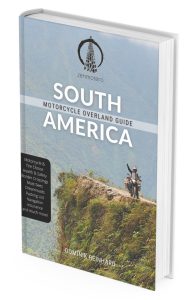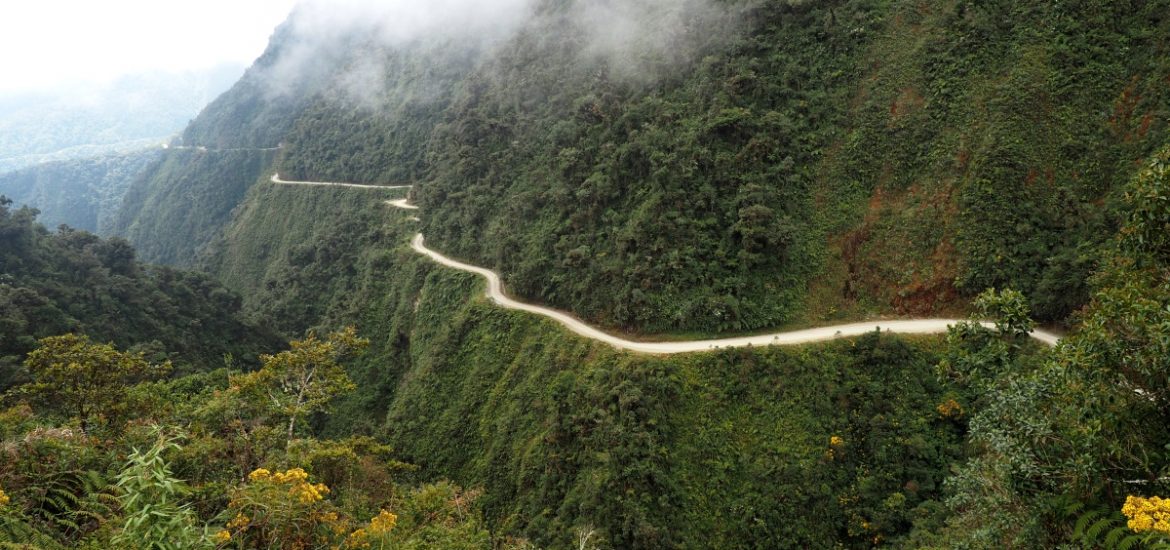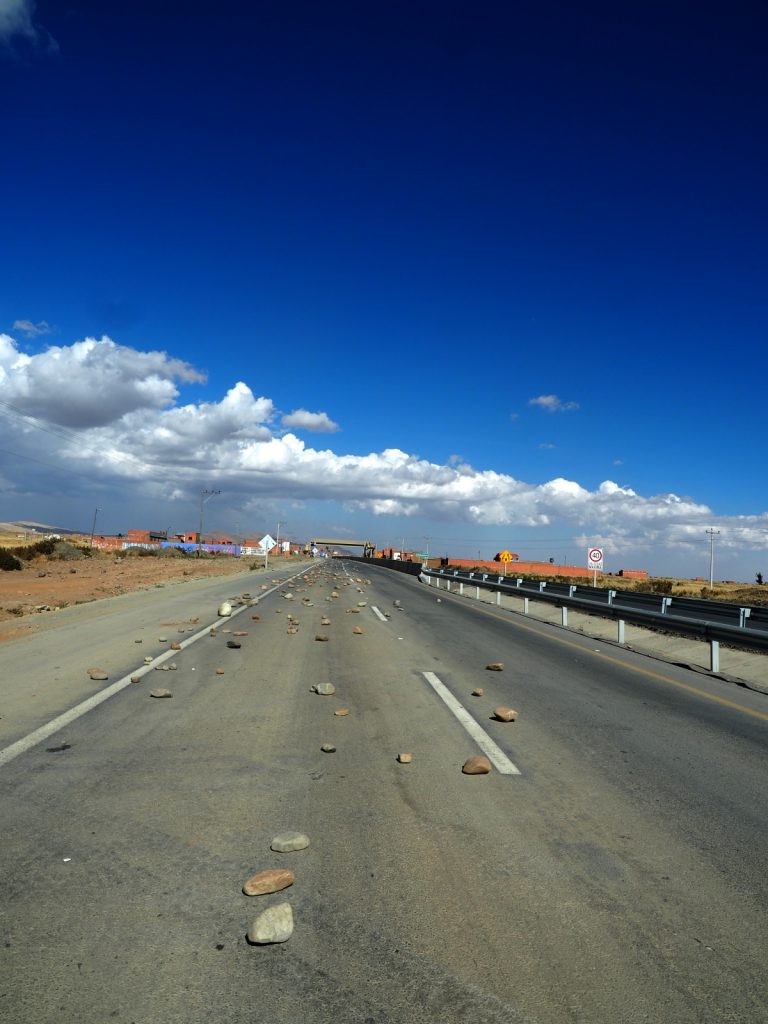I heard already a lot about the world’s most dangerous road in Bolivia which is known under several names like the Yungas Road, El Camino De La Muerte or simply the Death Road. Is it really so dangerous? As a scientist by training, I wanted to find out…
About
The Yungas road is a 69 km winding road stretch, connecting the world’s highest administrative capital of La Paz to the small Amazonian rain forrest town of Coroico. The road has been built in the 1930s by Paraguayan prisoners during the Chaco War and is cutting the hush, green vegetation of the Cordillera Oriental Mountain Chain like a sharp knife.
I started my adventure… late again. I simply enjoyed the neighbourhood of Sant Miguel in La Paz too much in order to leave early in the morning. Instead, I was enjoying a delicious breakfast at the “Corner Coffee” while the sun was shining pleasantly on my face.
It was about time to leave and to start my next adventure when the unexpected happened. I was just putting my gloves and my helmet on while an old lady in a white SUV “TRIED” to park backwards just behind my motorbike. The guy who was supposed to take care of my vehicle and who was supposed to give indications while the lady was trying to park her truck was a complete fall-out!!!!
I just could not react anymore and thought the vehicle would be stopping just in time. I mean, it was obvious that she was directly driving into me… Apparently not for her… and not for the instructor who I was previously paying a couple of Bolivianos for “doing his job”.
She slowly but steadily pushed my bike including me on the ground! When I got up, I immediately pushed up the bike again while a little petrol was leaking out of my containers. However, After cursing and checking if my bike was ok the lady came around the corner to apologise and was about to leave again. Obviously in a hurry for whatever reason… Luckily there was no damage on the bike and the “Barbarian” gave me a small tip for my inconvenience. Muchas gracias!!!
My day started instead of the Death Road with a Death Driver… Amazing!
However, after brushing off the dust of my motorbike clothes I started the engine of my 700 and headed off towards Coroico.
How to Get There
Starting off from La Paz and an altitude of approximately 4’650 m at the Cumber pass I gradually descended to finally 1’200 m at Coroico while enjoying amazing views on the local mountain ranges. Instead of taking the Death Road I drove the newly built asphalted road which is covering most of todays traffic. Having said, it was unbelievable difficult to find the right choice in terms of clothing. While 7 degrees Celsius were paralysing my fingers up on the mountain pass, I lost 5 litres of sweat in the tropical heat of Coroico.
Somehow I managed to take another thrilling road up to Coroico instead of the Death Road which truly deserved its name as a difficult stretch to drive. The road could barely carry a car, was full of mud and water as well as lose rocks. Even though it took me just 20 minutes to drive up to the town I was out of breath and the focusing on the difficulties was making me absolutely exhausted.
Where to Stay in Coroico
I was trying to find a hostel where I could also park my bike which was unfortunately not so easy. After the first hostel was completely closed and the second was only having outside parking I decided to stay in the Hotel El Viejo Molino a bit outside of town. Surely they had sufficient parking space but also high room prices of 260 Bolivianos. I tried to negotiate but I guess the hotel manager saw my desperate face and did not want to let go of his premium price.
I would have understood if the price benefit ratio would be in line with my expectations but it certainly was not. The only benefit of the hotel was a large pool in front of it where I relaxed for the rest of the day. Unfortunately I did not realise that I was not in the high Altiplanos anymore but at the foot of the Amazon’s jungle. Hot, humid… MOSQUITOS!!!! They were eating me alive!
Before you Ride the Death Road
The next day I simply wanted to leave very early in order to prevent crossing the path of the mountain bikers. I managed to get out of bed and was about to take my breakfast while I realised the restaurant only opened at 8 am. Great… Since I did not want to ride the death road with an empty stomach, I went back again to my room and slept for another round.
When I finally hit the Death Road it was already 10 am and of course I did not have to wait long to cross the first downhill bikers. Since I am usually mountain biking as well I usually had sympathy for the sport, until then. Most of the young bikers were clearly riding a mountain bike for the first time in their life… Well, I am not sure if I actually preferred the more experienced ones either since apparently they were looking for breaking the speed record to reach Coroico.
Even though the Yungas road lost its average yearly death rate of approx. 200 – 300 people due to the newly built side road, the camino de la muerte shows still no mercy. It is said that 22 cyclists have lost their lives since 1998. In fact, it was not surprising me when seeing those risk takers going downhill like that and especially in combination with sharp narrow curves, limited visibility, lose rocks, water and mud! Many crosses and altars along the Death Road were witnesses of the tragic end of so many people…
Driving the road uphill gives you the advantage to drive along the mountain side while vehicles and apparently also mountain bikers need to keep to the cliff side. When the groups of mountain bikers were spotting they did not know how to react… some people were suddenly coming on my side and did not even break, possibly of fear to jump over the cliff which I perfectly understood. I am just wondering if they did not get the proper instructions from their guides… My conclusion for mountain biker on the death road: Only skilled bikers should risk the downhill. Greenhorns should better avoid this risky road.
One positive aspect of sharing the road with the bikers was the fact that I would have certainly missed the coolest but also scariest picture opportunity at a cliff which went down a couple of hundreds of meters. After a group was finished with posing, I asked the guide to take a picture of me as well and I was more than happy of the result.
On my way, I met another crazy dude from Argentina on his enduro bike going downhills. Even though, he did not speak English and me not Spanish we managed to have a nice conversation and a lot of laughs. I hope to see him again in Buenos Aires with some more Spanish skills at this time (or Emilie has to translate, lol).
After approx. 2 hours I arrived at the end of the Death Road and finally survived. It was an amazing experience in a surreal landscape full of mystery which I was happy to have successfuly mastered. I was a bit scared at first, to be absolutely honest with you.
Survived and Continued to Copacabana
However, the day was not over yet and I was about to contact Javier in order to find out if the dangerous situation on the way to Copacabana has been resolved or not. Erwin, his father was warning me of a strike in between La Paz and Copacabana which could result in a bad end. Of course, when I arrived in La Paz my battery was dead and I was not bothered to look for a place to recharge it. Spontaneously I asked a policeman at the toll and he guaranteed me there would be no more risk.
On my way out of the city a mini bus was hitting my bike, bringing me out of line but luckily nothing happened. The traffic in South America is the real cause for many more deaths on the roads than the famous “Death Road” is.
Road Blockage
After 1,5 hours on the road I suddenly saw huge rocks laying on the road and I had to consequently slow down. Apparently, the road blockage was not over yet and after the rocks I could see tons of people sitting on the asphalt. I was thinking about the warning of Erwin but did not want to drive back. I put my biggest smile on my face and passed the many people slowly like a skiing competition. People were friendly and even greeted me… luckily!!!!
Lake Titicaca
Thereafter, I reached after an absolutely breathtaking road and a short ferry ride the Titicaca lake. I have never seen such a deep, blue colour in my whole life. It was absolutely fascinating and I had almost tears in my eyes, while enjoying the scenery at sunset.
I arrived Copacabana after a loooooooong day full of amazing adventures.
WOW! WHAT A DAY!!!!!!!!
Some Impressions
Motorcycle Overland Guide South America

In his upcoming new book, Dominik Reinhard will show you how to confidently overland South America by motorcycle. Filled with expert advice, interviews, case studies, insights, local tips and useful references and addresses, the zenmotero overland guide is essential reading for anyone interested in overlanding South America by motorcycle, weather you are new to overlanding or an experienced overland traveler starting again.

















